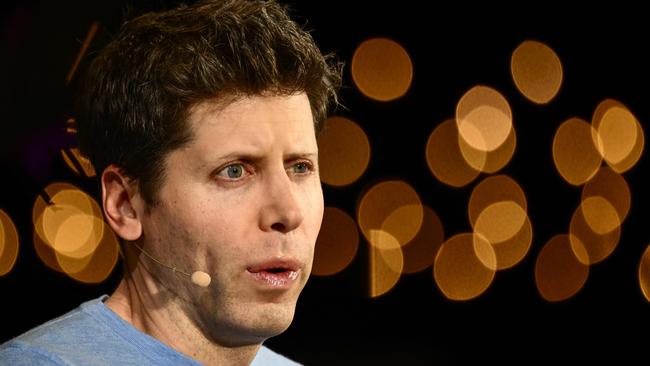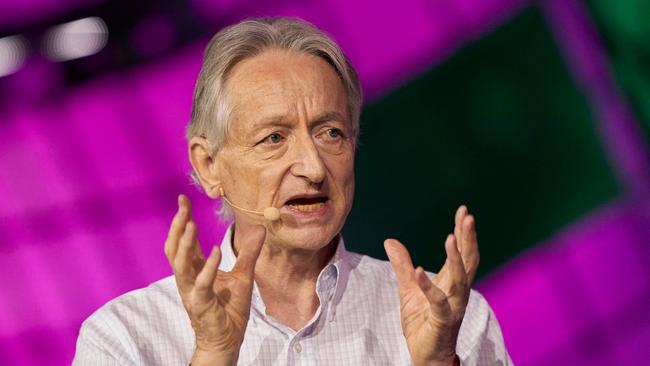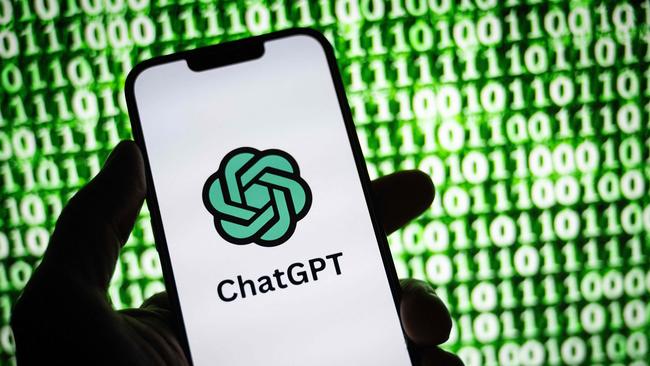How it all blew up for AI’s Oppenheimer
Sam Altman turned ChatGPT into a $US90bn giant – then was fired in mysterious circumstances.

As night fell over the San Francisco Bay on Thursday, Sam Altman, the face of the artificial intelligence revolution, the man New York Magazine dubbed the “Oppenheimer of our age”, sat down for a conversation with Android Jones, a digital artist.
Underneath a giant robotic face made of red neon lights, the pair held forth about the AI boom from inside a converted warehouse in a rough-and-tumble industrial district of Oakland, California. It was an intimate affair.
The 200 or so techies hung on Altman’s words. The 38-year-old billionaire had, more than anyone else, become the figurehead of the dawning AI era. Almost a year ago to the day, he had authored the industry’s “Big Bang” moment with the release of the wildly capable and popular chatbot ChatGPT.
The birth of the bot
The bot, capable of passing standardised tests, penning screenplays and writing software code, inspired an investment frenzy not seen since the dawn of the internet amid breathless predictions that “everything is about to change”. It was a glimpse of a science-fiction future where smart machines replace vast swathes of intellectual work. Experts such as Geoff Hinton, the former Google computer scientist known as the “godfather of AI”, were stunned by how quickly the technology had evolved into an “existential threat”. It might be used to, say, come up with a new bioweapon or wreck elections with high-fidelity misinformation.

Open letters signed by leaders in the field begged companies to stop working on the most powerful models. “Advanced AI could represent a profound change in the history of life on Earth, and should be planned for and managed with commensurate care and resources,” read one.
Altman himself warned that there was a good chance he may also be building a doomsday device, but he pushed ahead anyway, positioning himself as the saviour from the future he was rushing to build. As of this month, more than 100 million people use ChatGPT every week, making OpenAI – the company behind it, of which Altman was chief executive – one of the most extraordinary business successes of this century.
At the warehouse event Altman was relaxed, according to attendees. He was certainly not giving “I’m about to get fired” vibes. Hours later, however, he was.
OpenAI, based in San Francisco, stunned the tech world when it announced on Friday afternoon that Altman had been let go after “a deliberative review process by the board, which concluded that he was not consistently candid in his communications with the board”.
The vagueness of the statement set off wild speculation about the events that had led to his dismissal. It was not long ago that Altman had secured an audience with Rishi Sunak at No 10. He sat down with President Biden in the White House. He testified before Congress about the potential and peril that AI represented.
People compared his defenestration to the famed ousting of Steve Jobs from Apple in the 1980s. “Sam Altman is a hero of mine,” said Eric Schmidt, the billionaire former boss of Google. “He built a company from nothing to $US90 billion in value, and changed our collective world for ever. I can’t wait to see what he does next. I, and billions of people, will benefit from his future work – it’s going to be simply incredible.” Brian Chesky, the co–founder of Airbnb, added: “Sam Altman is one of the best founders of his generation and has made an immense contribution to our industry.”
The board of OpenAI, however, was ready to get shot of him. According to a tweet from Greg Brockman, an OpenAI co-founder who quit in protest, the wheels were set in motion on Thursday by Ilya Sutskever, chief scientist and board member.
Sutskever, who previously worked with Hinton at Google, texted Altman that evening, asking to meet on Friday at noon. When Altman logged on to the Google Meet link, the whole board was there – minus Brockman – and they informed him he was fired.
Minutes later Brockman was told he was being removed from his position as chairman of the board but could remain at the company. Brockman declined. “I’m super proud of what we’ve all built together since starting in my apartment eight years ago ... But based on today’s news, I quit,” he said in a short note to OpenAI employees. In a tweet, he added: “Sam and I are shocked and saddened by what the board did today.”
What the precipitating event was, the crossed line that motivated the board to act, remained unclear but clues began to emerge. OpenAI has a bizarre corporate structure. It is a for-profit company but is governed by a non-profit board whose primary focus is building “a computer that can think like a human in every way and use that for the maximal benefit of humanity”.
In a hastily arranged “all hands” meeting on Friday with employees, Sutskever responded to a question over whether this was a coup. “I can understand why you chose this word, but I disagree with this,” he said, according to The Information. “This was the board doing its duty to the mission of the non-profit, which is to make sure that OpenAI builds AGI [artificial general intelligence] that benefits all of humanity.”
Late on Friday three of OpenAI’s senior researchers also tendered their resignations in protest.
Ultimate goal of power
Paul Graham, co-founder of the famed Y Combinator startup boot camp, used to spend his days hearing pitches from wide-eyed founders. In 2005 one of them was Altman, the eldest of four children of a dermatologist mother and real estate broker father. He had arrived from suburban St Louis to Palo Alto two years prior to studying at Stanford University, just as Silicon Valley was coming back to life after the dotcom bust. He pitched Graham on a friend-finding app. Graham invested, and he saw something in the wiry, soft-spoken entrepreneur, who soon dropped out to work on his idea. Altman worked relentlessly, so much so that he gave himself scurvy that first summer.

He was also possessed of a self-confidence that he accrued despite his “awkward” upbringing as a gay Jewish kid in the Midwest. “A big secret,” Altman once wrote, “is that you can bend the world to your will a surprising percentage of the time – most people don’t even try.”
In 2009 Graham, a revered figure in Silicon Valley, named the 24-year-old Altman as one the most interesting startup founders alongside Apple’s Steve Jobs and Google’s Larry Page and Sergey Brin. Altman’s startup was a mild success, but Graham passed him the baton at Y Combinator, which he ran until 2018 to take over at OpenAI. “Sam is extremely good at becoming powerful,” Graham once told The New Yorker. “I think his goal is to make the whole future.” Indeed, while at Y Combinator Altman backed companies working on everything from 3D-printed rockets to reversing ageing. Some of his biggest successes included bets on Airbnb, Dropbox and Reddit.
He became very rich and amassed the toys and eccentricities of the fully realised tech bro. Altman, a vegan, bought a ranch in Napa. He snapped up supercars and built a doomsday bunker on the coast stocked with gold, antibiotics and gas masks.
In 2015 OpenAI emerged as a side project. Elon Musk was freaking out. He was building AI for his cars at Tesla and could see where the technology might go. He became convinced that building super-intelligent machines was akin to “summoning the demon” and presented the “biggest existential threat” to the human race.

So he and a few other techies – Altman among them – scraped together $US1 billion to launch a nine-person research lab with a quixotic mission to develop the technology for the good of the human race, “unconstrained by a need to generate financial return”. OpenAI was born.
By 2018, however, Musk came into conflict with the charity he had founded, partially because Tesla was starting to compete for the same talent. He left. A month later, Altman took over as chief executive. He wasted no time in making a very big change. Tools such as ChatGPT are “trained” on vast data sets: the entire written internet, for example. When someone writes a question or text prompt, its algorithms guess, based on everything they have ingested, the best and most likely answer.
The computing power required to train these systems, and then to handle queries, is wildly expensive. Altman needed money. So in March 2019 he changed OpenAI into a hybrid organisation that still had a non-profit board focused on the “pro-humanity” mission, but added a “capped profit” corporate structure.
The set-up allowed investors to buy into OpenAI, but capped returns at 100 times the money they put in.
Creating such a high bar appeared absurd: a threshold so high as to be meaningless – unless you believed that OpenAI might actually develop AGI. If it pulled that off, then it would hoover up a significant chunk of the global economy. Altman, of course, is a believer. He started another company, Worldcoin, which scans people’s eyeballs to assign them a unique digital ID so that when we are all out of work due to AGI we can better receive the universal basic income cheques we’ll need to survive.
The first investor Altman lured into his newly transformed OpenAI was Microsoft. The software giant invested dollars 1 billion in 2019, supercharging his plans. Last year’s ChatGPT release stunned the world with its capabilities. It also had problems. It would confidently make things up. It could be manipulative.
Critics, meanwhile, bashed OpenAI for going back on the company’s founding pledge to share its technology for the good of the world. The company began to closely protect its code, the data it used, and how its tools were built. OpenAI became a black box. The reason for this reversal, according to Vinod Khosla, an early investor, was safety. It would be “like open-sourcing the Manhattan project”, he said. Altman meanwhile pleaded for regulation, telling Congress that it should pass laws requiring any company to receive government approval before releasing powerful models.
His strategy was, in effect: trust me. This tech is extremely powerful – we will develop it responsibly – but most other firms shouldn’t be allowed to. Rivals saw Altman’s regulation plea as a cynical attempt to make it harder for others to compete.
Despite the scare stories, ChatGPT and its many pretenders caught the world’s imagination, awakening politicians and executives to the possibility that these machines, unlike previous inventions that automated brute labour, could take on swathes of cognitive work. A white-collar revolution hoved into view. And it inflamed something of a civil war in Silicon Valley between the “accelerationists” like Altman, who wanted to bring the future forward as quickly as possible, and the safety crowd, pejoratively referred to as “decels”, or decelerationists, who preached caution and a slower approach.

The Microsoft chief Satya Nadella put another $US10 billion into the company in March. OpenAI’s value skyrocketed. Altman had become a rock star. And so naturally he went on tour.
In May he embarked on a 22-country jaunt to meet with crowds, to hear how people were using his technology, to listen to their concerns. He met with Sunak and France’s President Macron, the German Chancellor, Olaf Scholz, and India’s leader, Narendra Modi. From the sidelines Musk fumed. “OpenAI was created as an open-source, non-profit company to serve as a counterweight to Google, but now it has become a closed-source, maximum-profit company effectively controlled by Microsoft,” he tweeted. “This was not what I intended at all.”
Musk was, apparently, not the only one discomfited by Altman’s approach.
The decisive blow
A fortnight ago Altman walked on to a stage in San Francisco to pull his latest rabbit out of the hat. OpenAI was launching a “GPT Store”.
Think of this as the App Store for the AI era. The iPhone’s release in 2007 set the world alight but it was not until a year later, when it opened the App Store, that it began to bend and break industries. Opening up its ecosystem to the world’s developers was what turned the iPhone into the centre of the tech solar system and produced a catalogue of killer apps, from ride-hailing to social media. These were not built by Apple, but by third parties who leveraged the system Apple built and the audience it had aggregated.
With the GPT Store – and a host of other new development tools – Altman was trying to pull off a similar trick. Imagine a world where anyone could easily build a custom bot, simply by asking for it in natural language. No code necessary. That is what the GPT Store promises.
It was an audacious landgrab. Altman had also unveiled an even more powerful language model, and it displayed a level of capability that is thought to have unsettled some of those focused internally – including Sutskever – on making sure the AI was “aligned” with human interests. Altman embarked on a new push to raise billions of dollars to fund his plan. As safety concerns simmered, it became a point of conflict internally. And in that battle, it appears, the “decels” struck the decisive blow.
While the company seeks a full-time replacement for its allegedly errant chief, it has hired in his place Mira Murati, the company’s 34-year-old chief technology officer, as interim chief executive.

Murati, a former executive at Tesla, is Albanian but moved to Canada aged 16 when she won a scholarship to an international school there. She went on to take a degree in mechanical engineering at the Ivy League New Hampshire university Dartmouth College and joined OpenAI in 2018. There, she oversaw the teams creating ChatGPT and its image-generating AI division Dall.E2.
A fan of the movie 2001: A Space Odyssey, in which the spaceship’s computer, HAL, goes rogue and turns on the human crew, she has spoken about the dangers of AI being abused by “bad actors” and stressed the importance of governments and regulators getting involved in protecting the public. However, she has described AGI in Fortune magazine as “the most important set of technologies that humanity has ever built”.
“Successfully transitioning to a world with super-intelligence,” OpenAI has said, “is perhaps the most important – and hopeful, and scary – project in human history.”
Given what he just pulled off, Altman will have venture capitalists lining up to give him money to try that project again – his way.
The Sunday Times




To join the conversation, please log in. Don't have an account? Register
Join the conversation, you are commenting as Logout